Logging Community-Based Forests in the Amazon: An Analysis of External Influences, Multi-Partner Governance, and Resilience
Abstract
1. Introduction
1.1. Community Forest Management: Constraints and Opportunities
1.2. Multi-Partner Governance
2. Materials and Methods
Tapajós National Forest: Geographic and Sociopolitical Context
3. Results and Discussion
3.1. Multi-Partner Governance for Community Forest Management
“… I think one of the main factors that contributed to the success [of Coomflona] was not necessarily the support they had; of course, it contributed, but it was their ability to reach out to other actors, to establish these partnerships”.(Research participant from SFB, personal communication, 23 October 2014)
“… [Partnership] is established under some conditions that benefit both. It brings benefits to all involved”.(Research participant from SFB, personal communication, 23 October 2014)
“… A partner is the one that stands with you when things get difficult. Just as in marriage, in sadness, and happiness. It is the one who helps and is helped. It stands side by side during difficult times and always tries to contribute”.(Research participant from Coomflona, personal communication, 5 December 2014)
3.2. Multi-Partner Governance Outcomes: Conservation, Development, and Resilience
- Spaces for inter-sector dialog bringing together agents from the state, market and society;
- Capacity of social actors to build a minimum consensus to tackle social and environmental dilemmas such as who has rights to access natural resources and how to use them both for conserving forests and promoting local livelihoods improvements;
- New governance arrangements (multi-partner) to promote social learning and knowledge sharing to advance with new practices for community forest management, as well as to ensure human, financial, and technological resource complementarity to find out new economic alternatives to support community sustainable livelihood.
3.3. Multi-Partner Governance System: Challenges and Recommendations
“… ICMBio’s time is not always Coomflona’s time. There are things that we [at ICMBio] want for the Tapajós National Forest as a whole, which oftentimes are not included in Coomflona’s annual planning”.(Research participant from ICMBio, personal communication, 23 January 2015)
4. Conclusions
Author Contributions
Acknowledgments
Conflicts of Interest
References
- Gilmour, D. Forty Years of Community-Based Forestry, FAO Forestry Paper 176; FAO: Rome, Italy, 2016; p. 140. ISBN 978-92-5-109095-4. [Google Scholar]
- Pokorny, B.; Pacheco, P. Money from and for Forests: A Critical Reflection on the Feasibility of Market Approaches for the Conservation of Amazonian Forests. J. Rural Stud. 2014, 36, 441–452. [Google Scholar] [CrossRef]
- Porter-Bolland, L.; Ellis, E.A.; Guariguata, M.R.; Ruiz-Mallén, I.; Negrete-Yankelevich, S.; Reyes-García, V. Community Managed Forests and Forest Protected Areas: An Assessment of Their Conservation Effectiveness across the Tropics. For. Ecol. Manag. 2012, 268, 6–17. [Google Scholar] [CrossRef]
- Buschbacher, R.; Athayde, S.; Bartels, W.-L.; Mello, R. Resilience Assessment as a Tool for Understanding the Amazon Frontier as a Social-Ecological System. Sustentabilidade em Debate 2016, 7, 20. [Google Scholar] [CrossRef]
- Sterling, E.; Ticktin, T.; Kipa Kepa Morgan, T.; Cullman, G.; Alvira, D.; Andrade, P.; Bergamini, N.; Betley, E.; Burrows, K.; Caillon, S.; et al. Culturally Grounded Indicators of Resilience in Social-Ecological Systems. Environ. Soc. 2017, 8, 63–95. [Google Scholar] [CrossRef]
- De Janvry, A.; Sadoulet, E. Development Economics: Theory and Practice, 1st ed.; Routledge: New York, NY, USA, 2016; ISBN 978-11-3-888531-8. [Google Scholar]
- Bustamante, M.M.C.; Roitman, I.; Aide, T.M.; Alencar, A.; Anderson, L.O.; Aragão, L.; Asner, G.P.; Barlow, J.; Berenguer, E.; Chambers, J.; et al. Toward an Integrated Monitoring Framework to Assess the Effects of Tropical Forest Degradation and Recovery on Carbon Stocks and Biodiversity. Glob. Chang. Biol. 2016, 22, 92–109. [Google Scholar] [CrossRef] [PubMed]
- May, P.H.; Millikan, B.; Gebara, M.F. The Context of REDD+ in Brazil. Drivers, Agents and Institutions, CIFOR Ocassional Paper, 2nd ed.; CIFOR: Bogor, Indonesia, 2011; p. 80. ISBN 978-60-2-869332-5. [Google Scholar]
- Tegegne, Y.T.; Lindner, M.; Fobissie, K.; Kanninen, M. Evolution of Drivers of Deforestation and Forest Degradation in the Congo Basin Forests: Exploring Possible Policy Options to Address Forest Loss. Land Use Policy 2016, 51, 312–324. [Google Scholar] [CrossRef]
- Faria, W.R.; Almeida, A.N. Relationship between Openness to Trade and Deforestation: Empirical Evidence from the Brazilian Amazon. Ecol. Econ. 2016, 121, 85–97. [Google Scholar] [CrossRef]
- Rice, J. The Transnational Organization of Production and Uneven Environmental Degradation and Change in the World Economy. Int. J. Comp. Sociol. 2009, 50, 215–236. [Google Scholar] [CrossRef]
- Paulson, S. Degrowth: Culture, Power and Change. J. Polit. Ecol. 2017, 24, 425–448. [Google Scholar] [CrossRef]
- Hickel, J. The pope versus the UN: who will save the world first? | Global Development Professionals Network | The Guardian. Available online: https://www.theguardian.com/global-development-professionals-network/2015/jun/23/the-pope-united-nations-encyclical-sdgs (accessed on 28 October 2017).
- Gould, K.A.; Pellow, D.N.; Schnaiberg, A. Interrogating the Treadmill of Production. Organ. Environ. 2004, 17, 296–316. [Google Scholar] [CrossRef]
- Mayers, J.; Vermeulen, S. Company-Community Forestry Partnerships. For. Dialogue Invest. Local. Control. For. (ILCF) 2012, 30, 117–118. [Google Scholar]
- Schmink, M. Communities, Forests, Markets, and Conservation. In Working Forests in the Neotropics: Conservation Through Sustainable Management? Zarin, D.J., Alavalapati, J.R.R., Putz, F.E., Schmink, M., Eds.; Columbia University Press: New York, NY, USA, 2004; pp. 119–129. ISBN 0-231-12906-8. [Google Scholar]
- Schmink, M.; Wood, C.H. Conflitos Sociais e a Formação Da Amazônia, 1st ed.; EDUFPA: Belém, PA, Brasil, 2012; ISBN 978-85-247-0513-7. [Google Scholar]
- Ostrom, E. A General Framework for Analyzing Sustainability of Social-Ecological Systems. Science 2009, 325, 419–422. [Google Scholar] [CrossRef] [PubMed]
- Espada, A.L.V.; Sobrinho, M.V.; de Miranda Rocha, G.; de Albuquerque Vasconcellos, A.M. Manejo Florestal Comunitário Em Parceria Na Amazônia Brasileira: O Caso da Flona do Tapajós. Rev. Bras. Gestão e Desenvolv. Reg. 2017, 13, 342–372. [Google Scholar]
- Radachowsky, J.; Ramos, V.H.; McNab, R.; Baur, E.H.; Kazakov, N. Forest Concessions in the Maya Biosphere Reserve, Guatemala: A. Decade Later. For. Ecol. Manag. 2012, 268, 18–28. [Google Scholar] [CrossRef]
- Duchelle, A.M.Y.E.; Wunder, S. Smallholder Specialization Strategies along the Forest Transition Curve in Southwestern Amazonia. World Dev. 2014, 64. [Google Scholar] [CrossRef]
- Reid, R.S.; Nkedianye, D.; Said, M.Y.; Kaelo, D.; Neselle, M.; Makui, O.; Onetu, L.; Kiruswa, S. Evolution of Models to Support Community and Policy Action with Science: Balancing Pastoral Livelihoods and Wildlife Conservation in Savannas of East Africa. Proc. Natl. Acad. Sci. USA 2009, 1–6. [Google Scholar] [CrossRef]
- Arts, B.; de Koning, J. Community Forest Management: An Assessment and Explanation of Its Performance Through QCA. World Dev. 2017, 96, 315–325. [Google Scholar] [CrossRef]
- Baynes, J.; Herbohn, J.; Smith, C.; Fisher, R.; Bray, D. Key Factors Which Influence the Success of Community Forestry in Developing Countries. Glob. Environ. Chang. 2015, 35, 226–238. [Google Scholar] [CrossRef]
- RRI. What Rights? A Comparative Analysis of Developing Countries’ National Legislation on Community and Indigenous Peoples’ Forest Tenure Rights; Rights and Resources Initiative: Washington, DC, USA, 2012. [Google Scholar]
- Cronkleton, P.; Saigal, S.; Pulhin, J. Co-Management in Community Forestry: How the Partial Devolution of Management Rights Creates Challenges for Forest Communities. Conserv. Soc. 2012, 10, 91. [Google Scholar] [CrossRef]
- RRI. Who Owns the World’s Land? A Global Baseline of Formally Recognized Indigenous and Community Land Rights; RRI: Washington, DC, USA, 2015. [Google Scholar]
- Larson, A.; Dahal, G. Forest Tenure Reform: New Resource Rights for Forest-Based Communities? Conserv. Soc. 2012, 10, 77. [Google Scholar] [CrossRef]
- Agrawal, A.; Lemos, M.C. A Greener Revolution in the Making? Environmental Governance in the 21st Century. Environment 2007, 49, 36–45. [Google Scholar] [CrossRef]
- Bray, D.B. Capitalism Meets Common Property. Americas Q. 2010, 4, 30–35. [Google Scholar]
- Humphries, S.; Holmes, T.P.; Kainer, K.; Koury, C.G.G.; Cruz, E.; de Miranda Rocha, R. Are Community-Based Forest Enterprises in the Tropics Financially Viable? Case Studies from the Brazilian Amazon. Ecol. Econ. 2012, 77, 62–73. [Google Scholar] [CrossRef]
- Morsello, C. Company-Community Non-Timber Forest Product Deals in the Brazilian Amazon: A Review of Opportunities and Problems. For. Policy Econ. 2006, 8, 485–494. [Google Scholar] [CrossRef]
- Pacheco, P.; Mejía, E.; Cano, W.; de Jong, W. Smallholder Forestry in the Western Amazon: Outcomes from Forest Reforms and Emerging Policy Perspectives. Forests 2016, 7, 193. [Google Scholar] [CrossRef]
- Charnley, S.; Poe, M.R. Community Forestry in Theory and Practice: Where Are We Now? Annu. Rev. Anthropol. 2007, 36, 301–336. [Google Scholar] [CrossRef]
- Terborgh, J.; Peres, C.A. Do Community-Managed Forests Work? A Biodiversity Perspective. Land 2017, 6, 22. [Google Scholar] [CrossRef]
- De Blas, D.E.; Ruiz Pérez, M.; Sayer, J.A.; Lescuyer, G.; Nasi, R.; Karsenty, A. External Influences on and Conditions for Community Logging Management in Cameroon. World Dev. 2009, 37, 445–456. [Google Scholar] [CrossRef]
- The International Tropical Timber Organization (ITTO). Reduced Impact Logging. Available online: http://www.itto.int/feature15/ (accessed on 11 Janruary 2018).
- Rockwell, C.; Kainer, K.A.; Marcondes, N.; Baraloto, C. Ecological Limitations of Reduced-Impact Logging at the Smallholder Scale. For. Ecol. Manag. 2007, 238, 365–374. [Google Scholar] [CrossRef]
- Serviço Florestal Brasileiro—SFB. Plano Anual de Ortoga Florestal 2017; SFB: Brasília, DF, Brasil, 2017.
- Confederação Nacional da Indústria—CNI. Perspectivas e Desafios na Promoção do Uso das Florestas Nativas do Brasil, 1st ed.; Confederação Nacional da Indústria: Brasília, DF, Brasil, 2018. [Google Scholar]
- Pinto, A.; Amaral, P.; Amaral, M. Iniciativas de Manejo Florestal Comunitário e Familiar Na Amazônia Brasileira 2009/2010, 1st ed.; Imazon, IEB, GIZ, SFB: Belém, PA, Brasil, 2011; ISBN 978-85-86212-36-9. [Google Scholar]
- Fearnside, P.M. Natural Riches of Amazonia, Deforestation and Its Consequences. Glob. L. Proj. News 2015, 12, 22–25. [Google Scholar]
- INPE. Monitoramento da Floresta Amazônica Brasileira por Satélite. Available online: http://www.obt.inpe.br/OBT/assuntos/programas/amazonia/prodes (accessed on 15 October 2017).
- Andersen, L.E.; Granger, C.W.J.; Reis, E.J.; Weinhold, D.; Wunder, S. The Dynamics of Deforestation and Economic Growth in the Amazon, 1st ed.; Cambridge University Press: Cambridge, UK, 2002; ISBN 0-521-81197-X. [Google Scholar]
- Barlow, J.; Lennox, G.D.; Ferreira, J.; Berenguer, E.; Lees, A.C.; Mac Nally, R.; Thomson, J.R.; de Barros Ferraz, S.F.; Louzada, J.; Oliveira, V.H.F.; et al. Anthropogenic Disturbance in Tropical Forests Can Double Biodiversity Loss from Deforestation. Nature 2016, 535, 144–147. [Google Scholar] [CrossRef]
- Pearson, T.R.H.; Brown, S.; Murray, L.; Sidman, G. Greenhouse Gas Emissions from Tropical Forest Degradation: An Underestimated Source. Carbon Balance Manag. 2017, 12, 3. [Google Scholar] [CrossRef] [PubMed]
- Pereira, D.; Santos, D.; Vedoveto, M.; Guimarães, J.; Veríssimo, A. Fatos Florestais Da Amazônia 2010, 1st ed.; Imazon: Belém, PA, Brasil, 2010; ISBN 978-85-8-621231-4. [Google Scholar]
- Fearnside, P.M. Deforestation in Brazilian Amazonia: History, Rates and Consequences. Conserv. Biol. 2005, 19, 728–733. [Google Scholar] [CrossRef]
- De Jong, W. Antecedentes, Realidad y Oportunidades Del Manejo Forestal Comunitário En América Latina. In Manejo forestal comunitario en América Latina: Experiencias, lecciones aprendidas y retos para el futuro; Sabogal, C., de Jong, W., Pokorny, B., Louman, B., Eds.; CIFOR: Borgor, Indonesia, 2008; pp. 37–76. ISBN 978-979-1412-73-5. [Google Scholar]
- Green, K.E. A Political Ecology of Scaling: Struggles over Power, Land and Authority. Geoforum 2016, 74, 88–97. [Google Scholar] [CrossRef]
- Sawhney, P.; Kobayashi, M.; Takahashi, M.; King, P.N.; Mori, H. Participation of Civil Society in Management of Natural Resources. Int. Rev. Environ. Strateg. 2007, 7, 117–132. [Google Scholar]
- Berkes, F. Evolution of Co-Management: Role of Knowledge Generation, Bridging Organizations and Social Learning. J. Environ. Manag. 2009, 90, 1692–1702. [Google Scholar] [CrossRef] [PubMed]
- Cox, M.; Villamayor-Tomas, S.; Epstein, G.; Evans, L.; Ban, N.C.; Fleischman, F.; Nenadovic, M.; Garcia-Lopez, G. Synthesizing Theories of Natural Resource Management and Governance. Glob. Environ. Chang. 2016, 39, 45–56. [Google Scholar] [CrossRef]
- Hyden, G.; Court, J. Governance and Development, World Governance Survey Discussion Paper 1; United Nations University: Tokyo, Japan, 2002. [Google Scholar]
- Andersson, K.; Chan, J. Theory and Conceptual Foundations of Natural Resources Governance. In Adaptive Cross-scalar Governance of Natural Resources; Barnes, G., Child, B., Eds.; Routledge: London, UK, 2014; pp. 12–20. [Google Scholar]
- Chaffin, B.C.; Gosnell, H.; Cosens, B.A. A Decade of Adaptive Governance Scholarship: Synthesis and Future Directions. Ecol. Soc. 2014, 19, 56. [Google Scholar] [CrossRef]
- Lebel, L.; Anderies, J.M.; Campbell, B.; Folke, C.; Hatfield-Dodds, S.; Hughes, T.P.; Wilson, J. Governance and the Capacity to Manage Resilience in Regional Social-Ecological Systems. Mar. Sci. Fac. Scholarsh. 2006, 11. Available online: http://www.ecologyandsociety.org/vol11/iss1/art19/ (accessed on 15 November 2017). [CrossRef]
- Reed, M.S. Stakeholder Participation for Environmental Management: A. Literature Review. Biol. Conserv. 2008, 141, 2417–2431. [Google Scholar] [CrossRef]
- Nobre, D.M.; Alarcon, D.T.; Cinti, A.; Schiavetti, A. Governance of the Cassurubá Extractive Reserve, Bahia State, Brazil: An Analysis of Strengths and Weaknesses to Inform Policy. Mar. Policy 2017, 77, 44–55. [Google Scholar] [CrossRef]
- Saito-Jensen, M. Theories and Methods for the Study of Multi-Level Environmental Governance; CIFOR: Bogor, Indonesia, 2015; p. 36. [Google Scholar]
- Barnes, G.; Child, B. Adaptive Cross-Scalar Governance of Natural Resources, 1st ed.; Routledge: London, UK, 2014. [Google Scholar]
- Lemos, M.C.; Agrawal, A. Environmental Governance. Annu. Rev. Environ. Resour. 2006, 31, 297–325. [Google Scholar] [CrossRef]
- Koury, C.; Rizzo, E. Gestão Participativa No Amazonas: A Experiência Na RDS Uatumã. In Áreas Protegidas; Sandrini, M., Queiroz, E., Eds.; Fundo Vale: RIo de Janeiro, RJ, Brasil, 2012; pp. 68–75. ISBN 978-85-65906-01-2. [Google Scholar]
- Ostrom, E. Background on the Institutional Analysis and Development Framework. Policy Stud. J. 2011, 39, 7–27. [Google Scholar] [CrossRef]
- Pinkerton, E.W. Translating Legal Rights into Management Practice: Overcoming Barriers to the Exercise of Co-Management. Hum. Organ. 1992, 51, 330–341. [Google Scholar] [CrossRef]
- Borrini-Feyerabend, G.; Farvar, M.T.; Nguinguiri, J.C.; Ndangang, V.A. Co-Management of Natural Resources: Organising, Negotiating and Learning-by-Doing; Reprint 20; GTZ (Gesellschaft für Technische Zusammenarbeit) and IUCN (The World Conservation Union), Kasparek Verlag: Heidelberg, Germany, 2007; ISBN 3-925064-30-3.
- Roopsind, A.; Wortel, V.; Hanoeman, W.; Putz, F.E. Quantifying Uncertainty about Forest Recovery 32-Years after Selective Logging in Suriname. For. Ecol. Manag. 2017, 391, 246–255. [Google Scholar] [CrossRef]
- Vasconcellos, A.M.D.A.; Sobrinho, M.V. Institutional Development for Good Governance: The Role of Intermediary NGOs in Pará State, Amazonia. Rev. Adm. Pública 2015, 49, 793–815. [Google Scholar] [CrossRef]
- Vasconcellos Sobrinho, M.; Teixeira, M.A.C. Partnership inside Governance Spaces: The Case of the Municipal Development Forum of Igarapé-Açú, Pará, Amazonia. Cad. EBAPE.BR 2017, 15, 720–735. [Google Scholar] [CrossRef]
- Schmoldt, D.L.; Kangas, J.; Mendoza, G.A. Basic Principles of Decision Making in Natural Resource and the Environment. Anal. Hierarchy Process. Nat. Resour. Environ. Decis. Mak. 2001, 1–13. [Google Scholar] [CrossRef]
- Sunderlin, W.D.; Angelsen, A.; Wunder, S. State of the World’s Forests 2003; FAO: Rome, Italy, 2003; pp. 61–73. [Google Scholar]
- Castro, E. Dinâmica Socioeconômica e Desmatamento Na Amazônia. Nov. Econ. 2005, 8, 5–39. [Google Scholar] [CrossRef][Green Version]
- Pulhin, J.M.; Larson, A.M.; Pacheco, P. Regulations as Barriers to Community Benefits in Tenure Reform. In People: community rights and forest tenure reform; Larson, A.M., Barry, D., Dahal, G.R., Colfer, C.J.P., Eds.; Earthscan: London, UK, 2010; pp. 139–159. ISBN 978-18-4-407918-6. [Google Scholar]
- Schlager, E.; Ostrom, E. Property-Rights Regimes and Natural Resources: A Conceptual Analysis. Land Econ. 1992, 68, 249–262. [Google Scholar] [CrossRef]
- Cotula, L.; Toulmin, C.; Quan, J. Better Land Access for the Rural Poor: Lessons from Experience and Challenges Ahead; IIED: Rome, Italy, 2006; ISBN 978-1-84369-632-2. [Google Scholar]
- Cox, M.; Arnold, G.; Villamayor Tomás, S. A Review of Design Principles for Community-Based Natural Resource. Ecol. Soc. 2010, 15, 38. [Google Scholar] [CrossRef]
- Yin, R.K. Estudo de Caso: Planejamento e Métodos, 4th ed.; Bookman: Porto Alegre, RS, Brasil, 2010; ISBN 978-85-7-780655-3. [Google Scholar]
- Bernard, H.R.; Wutich, A.; Ryan, G.W. Analyzing Qualitative Data. Systematic Approaches, 2nd ed.; SAGE Publications: Thousand Oaks, CA, USA, 2017; ISBN 978-14-8-334438-6. [Google Scholar]
- Nowell, L.S.; Norris, J.M.; White, D.E.; Moules, N.J. Thematic Analysis: Striving to Meet the Trustworthiness Criteria. Int. J. Qual. Methods 2017, 16, 1–13. [Google Scholar] [CrossRef]
- IBAMA. Floresta Nacional do Tapajós: Plano de Manejo; IBAMA: Brasília, DF, Brasil, 2004.
- ProManejo/IBAMA. Relatório Técnico-Financeiro Final do ProManejo; IBAMA: Brasília, DF, Brasil, 2007.
- Soares, E.S. Desafios, Resultados, Ameaças e Oportunidades em Unidades de Conservação na Amazônia: A Floresta Nacional do Tapajós, 2nd ed.; IBAMA: Belterra, PA, Brasil, 2004.
- Veríssimo, A. Influência do Promanejo sobre Políticas Públicas de Manejo Florestal Sustentável na Amazônia; Ministério do Meio Ambiente: Brasília, DF, Brasil, 2005; p. 49.
- Andrade, D.F.; Gama, J.R.V.; Melo, L.O.; Ruschel, A.R. Inventário Florestal de Grandes Áreas Na Floresta Nacional Do Tapajós, Pará, Amazônia, Brasil. Biota Amaz. Open J. Syst. 2015, 5, 109–115. [Google Scholar] [CrossRef]
- ICMBio. Relatório: Levantamento de Famílias sa Floresta Nacional do Tapajós; ICMBio: Santarém, PA, Brasil, 2015.
- de Andrade, D.F.C.; de Carvalho, F.M.; Silva-Ribeiro, R.B.; Dantas, J.B. Manejo Florestal Comunitário Como Estratégia de Gestão e Melhoria Da Qualidade de Vida Da População Tradicional Da Floresta Nacional Do Tapajós. Simpósio Nac. Áreas Protegidas 2014, 3, 249–256. [Google Scholar]
- Humphries, S.; Holmes, T.; Andrade, D.; McGrath, D.; Batista Dantas, J. Searching for Win-Win Forest Outcomes: Learning-by-Doing, Financial Viability, and Income Growth for a Community-Based Forest Management Cooperative in the Brazilian Amazon. World Dev. 2018. [Google Scholar] [CrossRef]
- Silva, J.N.M.; de Carvalho, J.O.P.; do Carmo Alves Lopes, J. Inventário Florestal de Uma Área Experimental Na Floresta Nacional Do Tapajós. Bol. Pesqui. Florest 1985, 10/11, 38–110. [Google Scholar]
- Kohlhepp, G. Conflitos de Interesse No Ordenamento Territorial Da Amazônia Brasileira. Estud. Avançados 2005, 16, 37–61. [Google Scholar] [CrossRef]
- Sablayolles, P.; Drigo, I.; Barthelon, S.; Espada, A.L.V.; Ezzine de Blas, D.; Piketty, M.G. O Manejo Florestal Sustentável Como Alternativa Na Reprodução Social de Comunidades No Oeste Paraense? In Relação Empresa/Comunidade no Contexto do Manejo Florestal Comunitário e Familiar: Uma contribuição do projeto Floresta em Pé; Cruz, H., Sablayolles, P., Kanashiro, M., Amaral, M., Sist, P., Eds.; IBAMA: Belém, PA, Brasil, 2011; pp. 149–170. ISBN 978-85-7300-360-4. [Google Scholar]
- Veríssimo, A.; Rolla, A.; Maior, A.P.; Monteiros, A.; Brito, B.; Souja, C., Jr.; Augusto, C. Áreas Protegidas Na Amazônia Brasileira: Avanços e Desafios; Imazon/ISA: Belém, PA, Brazil, 2011; pp. 1–72. Available online: https://imazon.org.br/publicacoes/2673-2/ (accessed on 15 November 2017).
- Dudley, N. Directrices Para La Aplicación de Las Categorías de Gestión de Áreas Protegidas; UICN: Gland, Suiza, 2008.
- Instituto Chico Mendes de Conservação da Biodiversidade, ICMBio. Instrução Normativa No 16, de 4 de Agosto de 2011. 2011. Available online: http://www.icmbio.gov.br/portal/images/stories/o-que-somos/in162011.pdf (accessed on 11 February 2019).
- Celentano, D.; Santos, D.; Veríssimo, A. A Amazônia e Os Objetivos Do Milênio 2010, 1st ed.; Imazon: Belém, PA, Brasil, 2010; ISBN 978-85-86212-34-5. [Google Scholar]
- Amaral Neto, M.; Carneiro, M.S.; Miranda, K.F. Análise de Acordos entre Empresas e Comunidades para a Exploração de Madeira em Assentamentos Rurais na Região da BR 163 e Entorno no Estado do Pará, 1st ed.; Instituto Internacional de Educação do Brasil Ministério: Belém, PA, Brasil, 2011; ISBN 978-85-60443-10-9.
- Putz, F.E.; Zuidema, P.A.; Synnott, T.; Peña-Claros, M.; Pinard, M.A.; Sheil, D.; Vanclay, J.K.; Sist, P.; Gourlet-Fleury, S.; Griscom, B.; et al. Sustaining Conservation Values in Selectively Logged Tropical Forests: The Attained and the Attainable. Conserv. Lett. 2012, 5, 296–303. [Google Scholar] [CrossRef]
- Espada, A.L.V.; Vasconcellos, M.S. Manejo Comunitário e Governança Ambiental Para o Desenvolvimento Local: Análise de Uma Experiência de Uso Sustentável de Floresta Na Amazônia. Adm. Pública e Gestão Soc. 2015, 7, 169–177. [Google Scholar] [CrossRef]
- Espada, A.L.V. Parceria enquanto dimensão da Governança Ambiental para o Manejo Florestal Comunitário na Amazônia: O Caso da Floresta Nacional do Tapajós; Universidade Federal do Pará: Belém, PA, Brasil, 2015. [Google Scholar]
- Wali, A.; Alvira, D.; Tallman, P.S.; Ravikumar, A.; Macedo, M.O. A New Approach to Conservation: Using Community Empowerment for Sustainable Well-Being. Ecol. Soc. 2017, 22. [Google Scholar] [CrossRef]
- McQuaid, R.W. Partnership and Urban Economic Development; Social Science Working Paper 13; Napier University: Edinburgh, Scotland, 1994; pp. 9–35. Available online: https://www.researchgate.net/publication/23752543_PARTNERSHIPS_AND_URBAN_ECONOMIC_DEVELOPMENT (accessed on 15 September 2015).
- Vasconcellos, M.; Vasconcellos, A.M.D.A. State-Civil Society Partnership: Issues for Debate and New Researches. Organ. Soc. 2011, 19, 701–717. [Google Scholar] [CrossRef]
- Pandeff, P.A.; Silva, J.G. Gestão Ambiental Aplicada a Exploração Sustentável de Recursos Naturais Em Unidades de Conservação. In Proceedings of the V Congresso Nacional de Excelência em Gestão, Niterói, RJ, Brasil, 2–4 July 2009; pp. 1–24. [Google Scholar]
- Adeodato, S.; Villela, M.; Betiol, L.S.; Monzoni, M. Madeira de Ponta a Ponta. O Caminho Desde a Floresta Até o Consumo., 1st ed.; Fundação Getúlio Vargas: São Paulo, SP, Brasil, 2011; ISBN 978-85-6-362002-6. [Google Scholar]
- Lentini, M.; Amorim, P.; Espada, A.L.V. Manejo Florestal para a Produção de Madeira em Unidades de Conservação. In Áreas Protegidas; Sandrini, M., Queiroz, E., Eds.; Fundo Vale: Rio de Janeiro, RJ, Brasil, 2012; pp. 133–137. [Google Scholar]
- Espada, A.L.V.; Andrade, D.; Vasconcellos, M. A Cooperação Para o Desenvolvimento Local: Inovação No Manejo Florestal Comunitário. In Proceedings of the V Colóquio Organizações, Desenvolvimento & Sustentabilidade “Inovações em Debate”, Belém, PA, Brasil, 28–30 October 2014; pp. 101–117. [Google Scholar]
- Jahan, S. Relatório do Desenvolvimento Humano 2015. In O Trabalho como Motor do Desenvolvimento Humano; PNUD: New York, NY, USA, 2015. [Google Scholar]
- Humphries, S.; Andrade, D.; McGrath, D. COOMFLONA: A Successful Community-Based Forest Enterprise in Brazil; Earth Innovation Institute: San Francisco, CA, USA, 2015. [Google Scholar]
- Lynam, T.; de Jong, W.; Sheil, D.; Kusumanto, T.; Evans, K. A Review of Tools for Incorporating Community Knowledge, Preferences, and Values into Decision Making in Natural Resources Management. Ecol. Soc. 2007, 12, 5. [Google Scholar] [CrossRef]
- Berkes, F. Community-Based Conservation in a Globalized World. Proc. Natl. Acad. Sci. 2007, 104, 15188–15193. [Google Scholar] [CrossRef] [PubMed]
- Conroy, M.J.; Peterson, J.T. Decision Making in Natural Resource Management: A Structured, Adaptive Approach, 1st ed.; John Wiley & Sons, Ltd: Garsington Road, Oxford, UK, 2013; ISBN 978-0-470-67175-7. [Google Scholar]
- Mendoza, G.A.; Martins, H. Multi-Criteria Decision Analysis in Natural Resource Management: A Critical Review of Methods and New Modelling Paradigms. For. Ecol. Manag. 2006, 230, 1–22. [Google Scholar] [CrossRef]
- Smith, P.D.; McDonough, M.H. Beyond Public Participation: Fairness in Natural Resource Decision Making. Soc. Nat. Resour. 2001, 14, 239–249. [Google Scholar] [CrossRef]
- Lister, S. Power in Partnership? An Analysis of an NGO’s Relationships with Its Partners. J. Int. Dev. 2000, 12, 227–239. [Google Scholar] [CrossRef]
- Trafford, S.; Proctor, T. Successful Joint Venture Partnerships: Public-Private Partnerships. Int. J. Public Sect. Manag. 2006, 19, 117–129. [Google Scholar] [CrossRef]
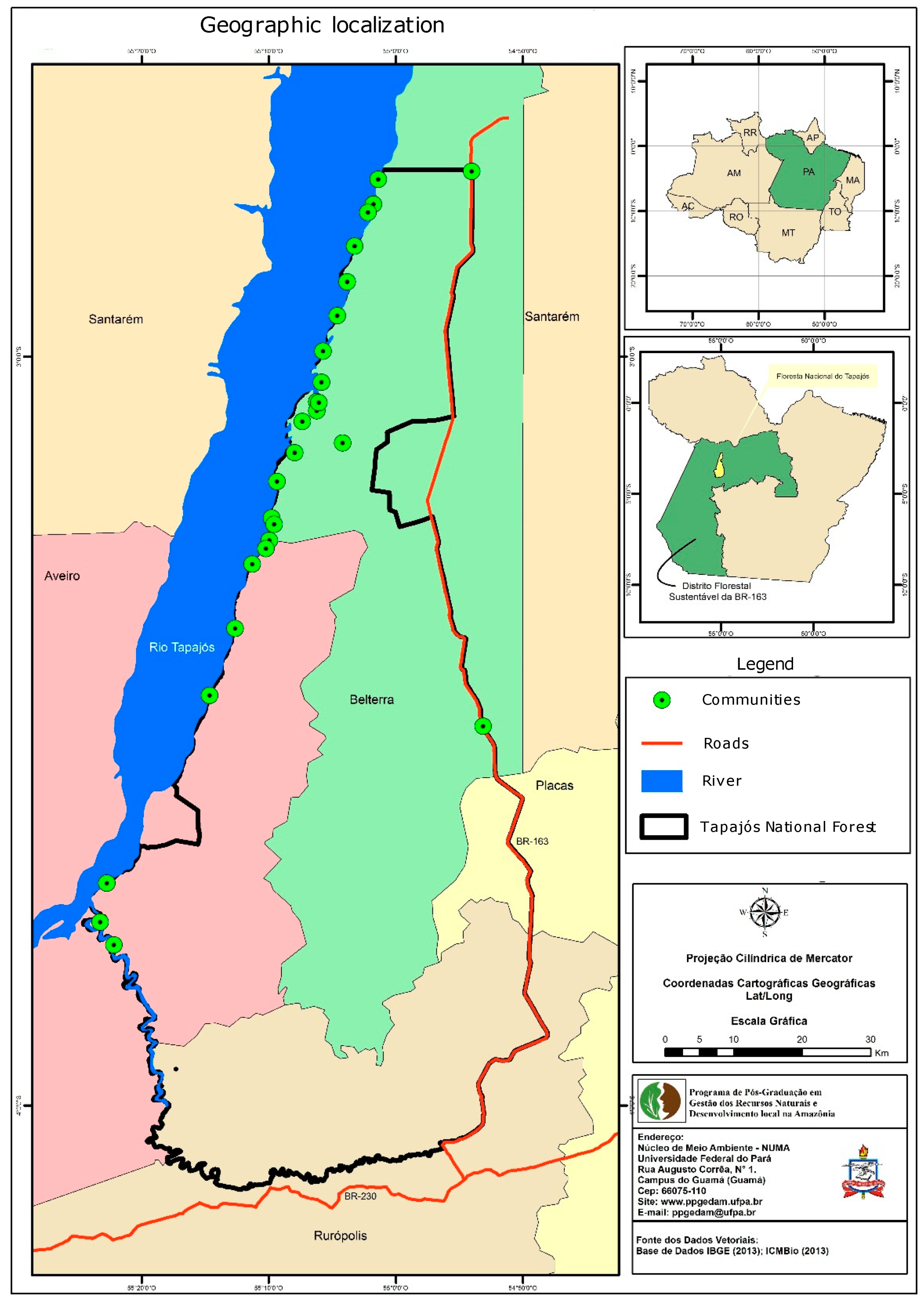
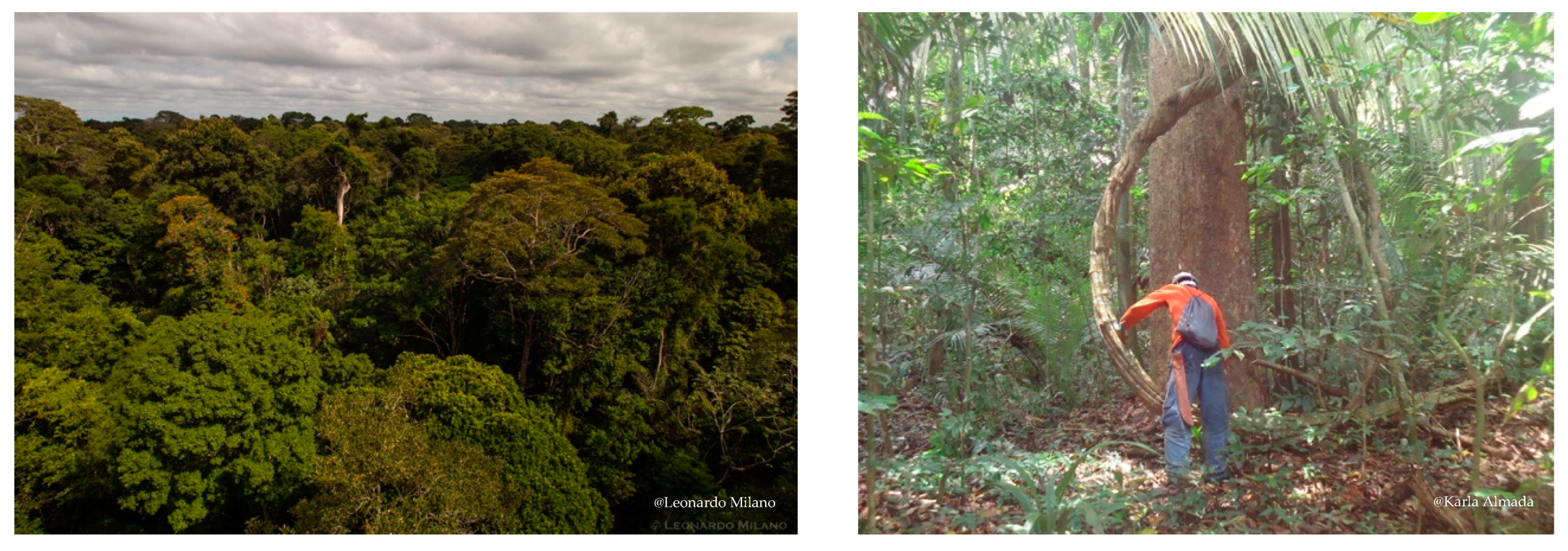


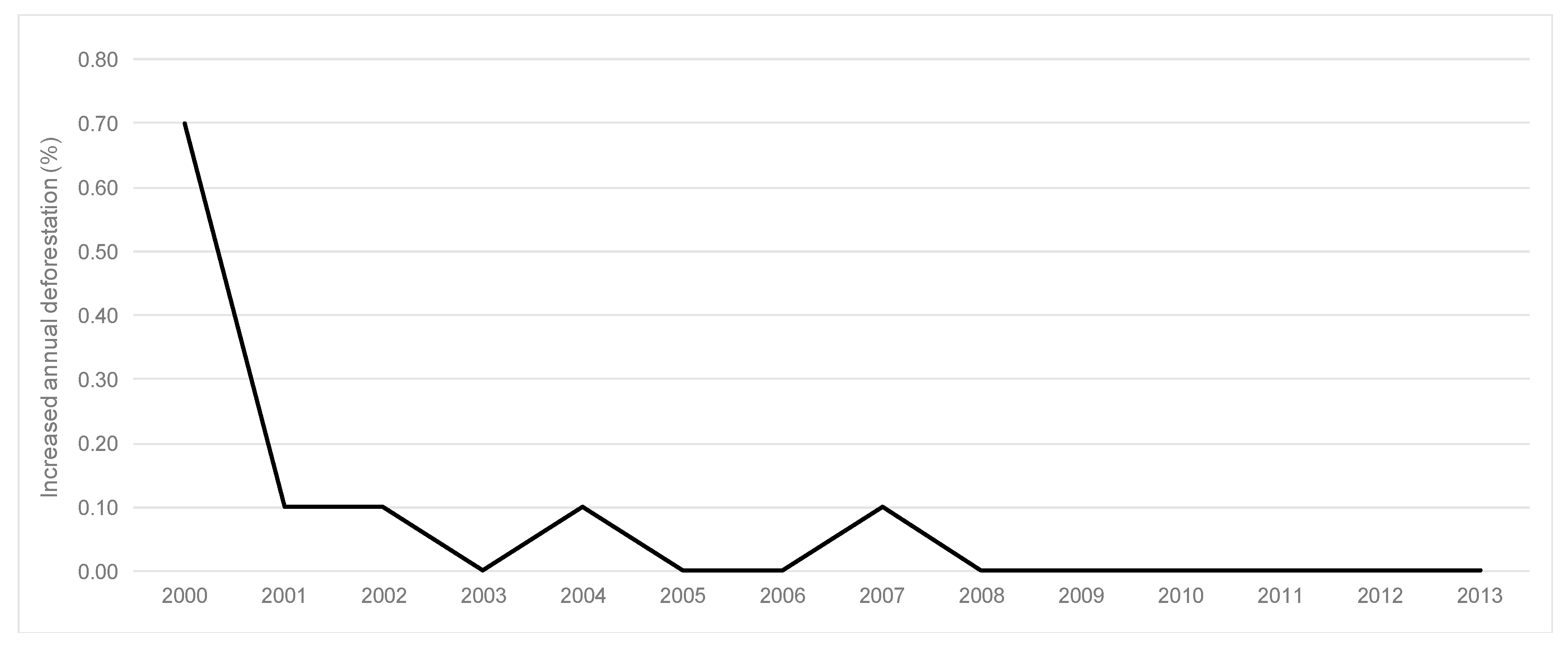
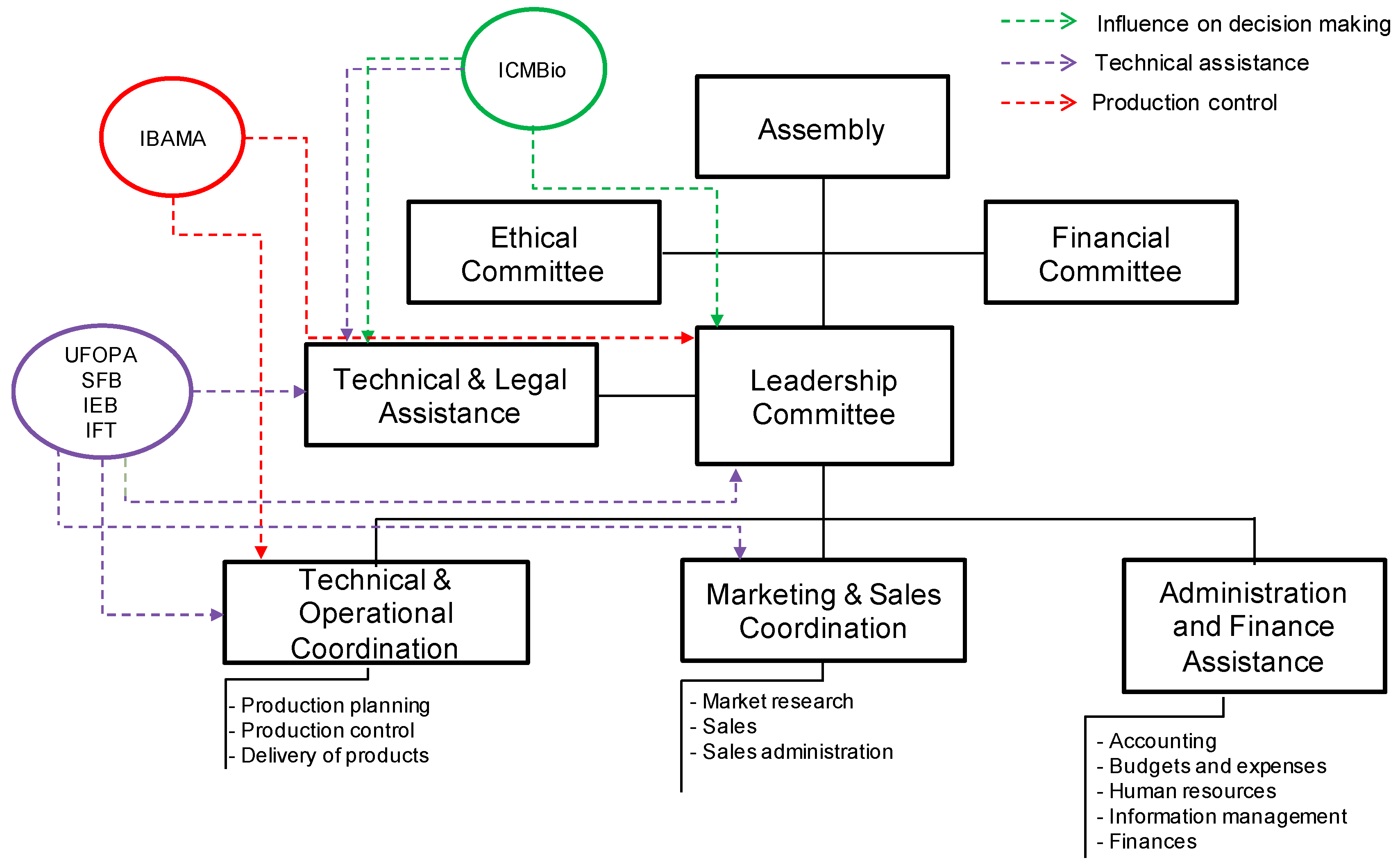
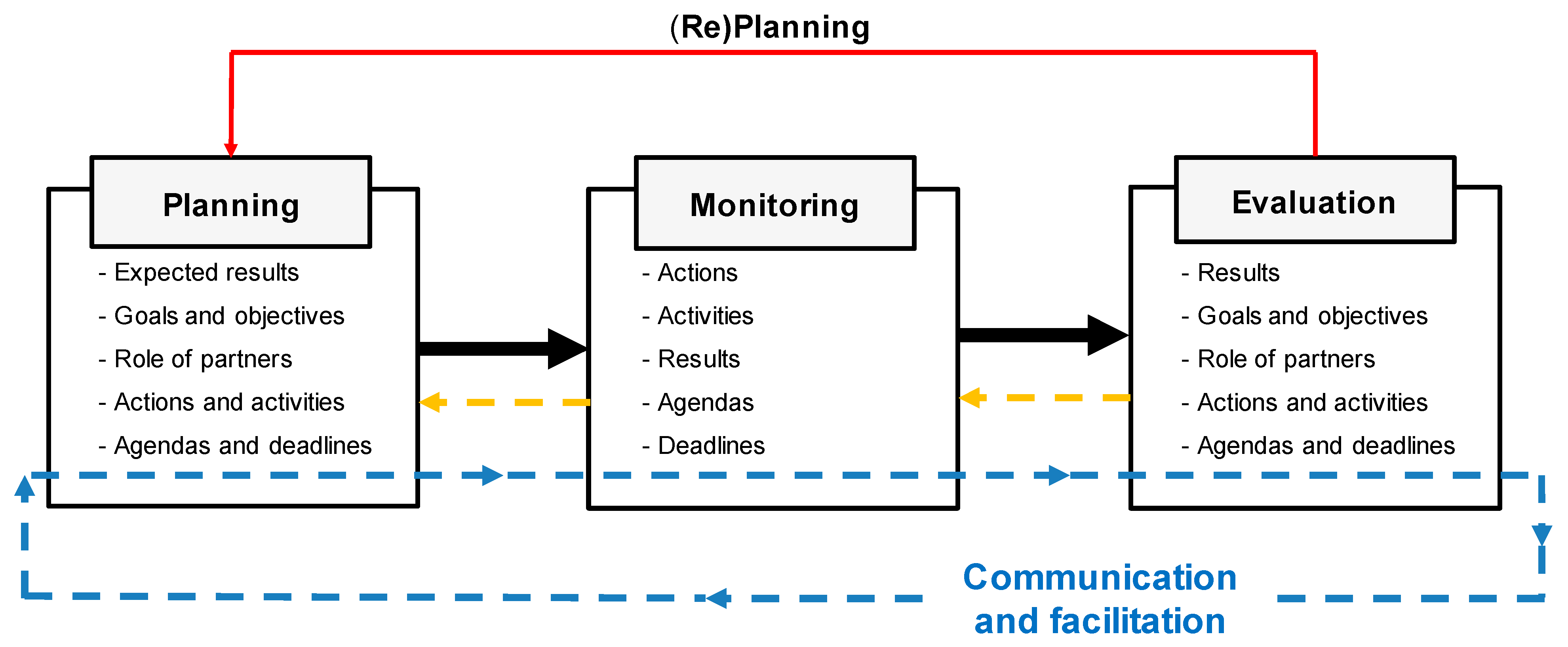
| Organization | Acronym * | Brief Description | Number Interviewed |
|---|---|---|---|
| Federation of Organizations and Traditional Communities of the Tapajós National Forest | FCFT | Representative entity of the forest-dwellers of the Tapajós National Forest. FCFT holds the land use concession contract. | 01 |
| Mixed Cooperative of the Tapajós National Forest | Coomflona | Community-based cooperative that does forest management in the Tapajós National Forest. | 04 |
| Brazilian Forest Service | SFB | Governmental agency responsible for the management of public forests. | 01 |
| Brazilian Institute of the Environment and Renewable Resources | IBAMA | Governmental agency responsible for the approval of community forest management in Tapajós National Forest. | 01 |
| Chico Mendes Institute for Biodiversity Conservation | ICMBio | Governmental agency responsible for the management of federal conservation units such as Tapajós National Forest. | 02 |
| Federal University of Western Pará | UFOPA | Public university located in Santarém, Pará state. | 02 |
| International Institute of Education in Brazil | IEB | Non-governmental organization that carries out actions to promote community forest management. | 01 |
| Project to Support Forest Management in the Amazon | ProManejo | Inter-governmental Brazilian project that developed adoption of sustainable forest management systems in the Amazon, with an emphasis on the harvesting of timber products, through strategic actions and demonstration projects, carried out from 1999 to 2006. | 02 |
| Year | Managed Area (ha) | Timber Production (m3) | Gross Revenue (USD) | Costs (USD) | Net Revenue (USD) |
|---|---|---|---|---|---|
| 2006 | 100 | 1544.80 | 201,850.19 | 182,893.32 | 18,956.87 |
| 2007 | 300 | 3650.80 | 284,299.88 | 229,734.24 | 54,565.65 |
| 2008 | 521 | 7843.30 | 161,876.53 | 165,706.05 | −3829.52 |
| 2009 | 700 | 13,421.70 | 475,926.81 | 352,737.10 | 123,189.71 |
| 2010 | 1000 | 14,266.90 | 551,721.77 | 508,722.15 | 42,999.62 |
| 2011 | 1000 | 15,064.00 | 777,173.10 | 612,308.45 | 164,864.65 |
| 2012 | 1000 | 18,894.20 | 912,923.43 | 877,324.04 | 35,599.39 |
| 2013 | 1000 | 22,027.94 | 1,030,700.07 | 873,277.83 | 157,422.24 |
| 2014 | 1600 | 35,000.00 | 1,487,939.46 | 1,368,952.28 | 118,986.99 |
| Funds | % | Brief Description |
|---|---|---|
| Investment | 45 | Investment in future activities (monitoring, harvesting, etc.). |
| Cooperative members | 20 | Benefits only the cooperative members with health care assistance or paid in cash in equal shares to cooperative members, like a dividend. |
| Community assistance | 15 | Benefits all communities located inside the Tapajós National Forest. The communities can submit a collective project to access a financial support from the cooperative. |
| Legal reserve | 10 | Savings infrastructure and future investment. |
| Health care | 5 | Benefits all communities. Used to improve conditions for health and welfare. |
| Social, educational, and technical assistance | 5 | Benefits cooperative members in accessing education and training. |
© 2019 by the authors. Licensee MDPI, Basel, Switzerland. This article is an open access article distributed under the terms and conditions of the Creative Commons Attribution (CC BY) license (http://creativecommons.org/licenses/by/4.0/).
Share and Cite
Espada, A.L.V.; Vasconcellos Sobrinho, M. Logging Community-Based Forests in the Amazon: An Analysis of External Influences, Multi-Partner Governance, and Resilience. Forests 2019, 10, 461. https://doi.org/10.3390/f10060461
Espada ALV, Vasconcellos Sobrinho M. Logging Community-Based Forests in the Amazon: An Analysis of External Influences, Multi-Partner Governance, and Resilience. Forests. 2019; 10(6):461. https://doi.org/10.3390/f10060461
Chicago/Turabian StyleEspada, Ana Luiza Violato, and Mário Vasconcellos Sobrinho. 2019. "Logging Community-Based Forests in the Amazon: An Analysis of External Influences, Multi-Partner Governance, and Resilience" Forests 10, no. 6: 461. https://doi.org/10.3390/f10060461
APA StyleEspada, A. L. V., & Vasconcellos Sobrinho, M. (2019). Logging Community-Based Forests in the Amazon: An Analysis of External Influences, Multi-Partner Governance, and Resilience. Forests, 10(6), 461. https://doi.org/10.3390/f10060461





